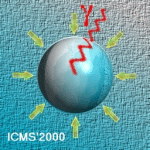
ICMS'2000
The International Conference on Multiphase Systems, ICMS'2000
Ufa, RUSSIA, June 15-17, 2000
Fedorov A. V., Gosteev Yu. A.
Institute of Theoretical and Applied Mechanics SB RAS, 630090, Novosibirsk, Russia
The theory of the stationary ignition wave in magnesium aerosuspension in two - velocity two - temperature approximation is developed. Specifically, the conditions such that the particle cloud ignites under the action of an initiating shock wave (SW) are defined. Within the limits of one-velocity mathematical model of the ignition wave, the nonadiabatic motion of the mixture behind the SW is considered. It is established that the ignition delay times obtained by the calculations are in good agreement with known experimental data.
Three types of the particle temperature behavior behind the SW are revealed for the two-velocity mixture flow. They are characterized by monotonic and nonmonotonic behavior with ignition and nonmonotonic behavior with "regular" heating (without ignition). Also two associated types of the gas phase temperature distribution are established. They are characterized by the same types of behavior too. Validation of the model is performed on the basis of comparison with the experimental data. An agreement between the one-velocity model and the two- velocity model on the ignition delay time for small particles is shown. Influence of particle size on this characteristic is compared for the both models. The unified formula for calculation of the induction period of the magnesium particle mixture in the oxygen which takes into account its dependence on the SW Mach number and particle radius is found.
The problem of ignition of the hydrocarbon fuel droplet cloud induced by the reflected SW is solved. Validation of the model is performed on the basis of comparison with the experimental data dealing with the tridecane droplet ignition delay time depending on shock wave Mach number.
The work is supported by grant INTAS OPEN 97-2027 and the Russian Foundation for Basic Research (grant 99-01-00587).